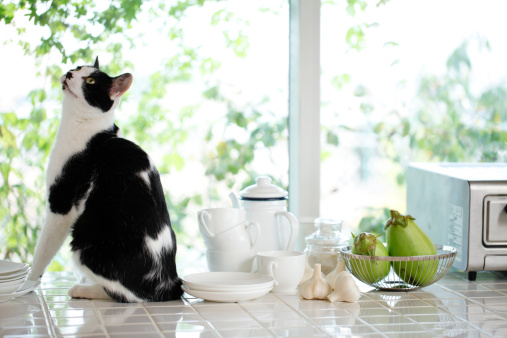Do a bit of searching on the internet and all sorts of horror stories of animals getting ill after flea treatments pop up (one ingredient in dog flea treatments is extremely toxic to cats and has caused seizures and death). Our poor pets – not only do they get the discomfort of horrible scratchy flea bites but they then usually have to deal with a complete chemical onslaught in the form of conventional flea treatment, which can often leave sores on their skin as well as cause rashes and respiratory problems (and who’s to say what long-term health issues?).
However there are plenty of ways you can keep your home free of fleas and I say that as someone who has lived with lots of animals and tried both conventional and natural approaches. Conventional treatments get stronger and stronger as fleas become immune to them (super fleas – eek!) but tackling the problem holistically not only gets rid of the pesky parasites but takes into consideration your pet’s long-term health and your family’s wellbeing. Spring is the best time to start small daily habits to help your pets and your home stay flea-free throughout the summer. Though your pets may only have just started to itch occasionally, prevention is truly better than cure when it comes to fleas and your animals will thank you!
Here are some natural ways to beat the fleas:
Groom your pet daily – this interrupts the life cycle of the flea and can really help get on top of a flea problem. A flea comb is cheap to pick up from pet shops and most large supermarkets and can be used in conjunction with a larger, softer brush for general grooming. When tackling a flea problem, have a bowl of hot water with a few drops of neem oil in it (see below for more information on this wonder oil) readily accessible. As you comb out the fleas, swipe the comb through the water and oil – this will kill any fleas you have combed out – and wipe the comb with a piece of kitchen towel or old rag before continuing. Eventually you get a build-up of neem oil on the comb and it begins to transfer slightly to your pet’s fur. That’s no bad thing as it is a great deterrent. Once you have a handle on a flea problem, you might like to simply brush your pet with an ordinary pet brush rather than a comb – they tend to prefer this anyway and it still acts as a deterrent to fleas and keeps the animal’s skin and fur healthy.
Use Neem oil – Neem oil comes from the kernels of neem tree fruit, a tree native to India. In all my years of having pets, I have never come across a better natural flea treatment. Be warned, however, it stinks! A bit like eggy garlic is the best way I can think to describe it, so when I use it I tend to add a drop or two of pure lavender essential oil to sweeten the smell (this is a natural flea repellent too). You can add some neem oil to a very gentle natural baby shampoo for bathing your pet, but you don’t want to bathe them too often as it can strip the animal’s coat and skin of their natural oils. Once a week bathing is recommended for flea prevention. If your animal has a flea problem use plenty of neem oil in the mild shampoo to nourish their stressed flea-bitten skin. The method above of flea combing using neem oil is also helpful. Simply rubbing a little neem oil between your palms and massaging your pet’s fur and into their skin is a quick fix if you don’t have time to groom or bathe them.
Try cedarwood, lavender and lemon essential oil spray – make up an effective flea spray for the home using these essential oils, fleas really hate them. Pick up a small spray bottle from a garden centre and fill with water. Add a dash of pure alcohol (such as vodka) as this helps the oils mix with the water rather than simply sitting on top. To this, add 10 drops each of the above essential oils, replace the lid and shake well. Use this mix to spray around the home: on soft furnishings, carpets, pet bedding, in corners and on doormats. (If you have expensive furniture, do a spot check first.) It smells lovely so acts as a refreshing room scent too but it really helps to keep the flea life cycle in check if you use it every couple of days. Don’t spray directly on your pet however as the alcohol can be a skin irritant and spray away from children. Cedarwood and lavender oils can be used in neem oil as a massage oil for your pet that really works and doesn’t smell too bad either.
Crush garlic in your pet’s food – many biting insects find the smell and taste of garlic repellent and thus lots of holistic animal websites recommend the use of garlic in your pet’s food to keep on top of a flea problem. I have to admit it hasn’t ever been the best solution for us, mainly because most of our animals have turned their noses up at garlic in their food! However, natural pet websites sell garlic capsules which can be pierced and sprinkled on your pet’s food and these don’t smell as strong. Or garlic oil is also an option. If you find that fleas are a constant source of worry over the summer months it’s certainly worth a try and in conjunction with other methods could well help keep your pet flea-free.
Vacuum regularly – Diatomaceous earth is made up of small ground fragments of marine algae which act as a desiccant on the exoskeleton of fleas, causing them to dehydrate and die. Many people swear by it as a way of tackling fleas in the carpet and furnishings but it’s not without its dangers. You need to wear protective goggles and a dust mask, with gloves as a safety precaution. No animals or children should be left in the home after you have sprinkled this fine dust on your carpet and furnishings. It is suggested you leave the diatomaceous earth on your carpet for six hours before vacuuming thoroughly. If you use food grade diatomaceous earth there are less risks with breathing it in. Whether you choose to use this stuff – and some say it really does work – or not, vacuuming regularly is key to tackling a flea problem. Use your vacuum’s nozzle to get down inside sofa cushions and into corners. Empty your vacuum bag into a bag which you can then seal tightly and dispose of straight away, as flea eggs can live and hatch in vacuum bags.
Pull up your carpet! – Extreme of course but if you have a few pets and find summer a horrible period of nipped ankles then this might be the answer. Fleas love carpet and even if you can’t see any jumping about in it, there’s likely to be eggs and larvae there. We decided to do this one year when we lived near a farm and our pets were bringing in fleas even with all the other methods we were using. One despairing day we pulled the carpet up and hey presto – half the problem we had before! Wood floors also look lovely and you can jazz them up with a nice rug during the cooler months when fleas aren’t such a problem. Now we live in a house with stone and wood floors throughout which, alongside the methods above, has practically eradicated the summer flea population.
Wash your pet’s bedding regularly – Make sure you wash your pet’s bedding at least once a fortnight during flea season and sprinkle with lavender essential oil. You can use the spray recipe above once the bedding has been washed to keep it flea-free. Remember to vacuum, sweep, and spray the area around your pet’s bed whilst the actual bed is in the wash.
Look after your pet – It goes without saying that you care for your pet but making sure they are in optimal health really goes a long way towards preventing fleas. A nourishing, healthy diet and regular grooming equates to healthy skin and animals in the best of health are far less likely to suffer from a flea infestation. Think of those poor malnourished animals who are rescued by animal shelters and almost all of them arrive starved and riddled with fleas and mites. Keeping your animal well fed and exercised is basic pet care but it does help. Anyone who is regularly grooming their pet is likely to notice a flea problem before it takes hold and can take immediate steps to eradicate the pests.







